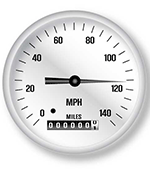Speeding Tickets
Speeding – Highway Traffic Act s.128
Associated charges: Stunt Driving | Careless Driving | Dangerous Driving | Photo Radar
About
The Highway Traffic Act of Ontario sets out the rules and penalties associated with speeding.
Penalties for speeding vary depending on how much the driver exceeds the speed limit and their class of drivers licence. These penalties include fines, demerit points, and in severe cases, suspension of the driver’s licence.
For instance, exceeding the speed limit by 50 km/h or more can lead to a charge of stunt driving, which carries severe penalties including a possible jail term.
Speeding Limits
Municipalities can reduce or increase speeds, but clear signage must be posted for motorists to see and to be made aware of.

Otherwise under the Highway Traffic Act (HTA) the speeding limits are:
- within the municipalities the speed limit is 50km/h,
- outside of the municipalities (e.g. country roads) the limit is 80km/h.
These speed limits do not have to be posted.
Only a police officer is allowed to issue a speeding ticket.
Speed Enforcement
Police officers are allowed to enforce the speed limit by:
- pacing motor vehicles
- radar and laser speed measurements
- using time and distance calculations
The speed limits only apply to Ontario roadways but police can do the enforcement from any location, e.g. the officer can park on private property and enforce the speed limit.
Photo Radar
Local governments are increasingly adopting the use of speed enforcement cameras. These devices focus on vehicles, capturing a photograph when the vehicle exceeds a predetermined speed limit.
Camera-issued speeding tickets differ from those given by police officers in several ways:
- They do not impact car insurance rates.
- No demerit points are assigned.
- The ticket is associated with the vehicle, not the driver.
- The offense is categorized similarly to a parking violation.
For more information visit the OntarioSpeeding.com photo radar information page information page.
Demerit Points
Demerit points are assigned to the driving record based upon the rate of speed recorded:
- 0 to 15 km/h – no loss of points
- 16 to 29 km/h – 3 points
- 30 to 49 km/h – 4 points
- 50km/h or more – 6 points/30 day suspension
Novice Drivers – Class G1 and G2 Drivers
Novice drivers are suspended for:
- any speeding ticket over 29km/h for 30 days
- exceeding novice driver
- demerit points accumulation levels
- exceeding novice driver
Insurance Implications
Speeding tickets affect insurance rates.
When a driver is found guilty of speeding, the court notifies the Ministry of Transportation about the conviction. The Ministry then updates the driver’s record with this speeding conviction.
Insurance companies, as private entities, have access to this information. While some insurers may not raise rates for a single ticket, others might.
A key issue is the uncertainty for drivers regarding their insurer’s response to a speeding ticket. Inquiring about the impact of a ticket could even prompt an insurance rate increase.
Licence Suspensions
Class G drivers face suspensions where the speed recorded is over 50km/h or where they exceed the demerit point limitations.
- All drivers more than 50km/h
- up to 6 months suspension
- up to 2 years if charged with stunt driving
Novice drivers:
Class G1 and G2 licence holders
-
- speeding more than 29km/h
- 30 day licence suspension
The suspension is for 30 days for exceeding the demerit point limitations for novice drivers.
Unpaid fines
All drivers face suspensions where a fine goes into default.
Where a drivers licence is suspended for an unpaid fine, the licence will be suspended until the payment is made to the court.
The reinstatement fee is $281.00
Demerit Point Suspensions
The accumulation of demerit points can result in a licence suspension.
- Class G licences receive a
- drivers licence interview at 8 points
- licence suspension at 15 demerits
- Class G1 and G2 Drivers are suspended for
- accumulating 6 demerit points
- any one ticket with 4 or more demerit points
Legal Definition
Highway Traffic Act s.128
(1) No person shall drive a motor vehicle at a rate of speed greater than,
(a) 50 kilometres per hour on a highway within a local municipality or within a built-up area;
(b) despite clause (a), 80 kilometres per hour on a highway, not within a built-up area, that is within a local municipality that had the status of a township on December 31, 2002 and, but for the enactment of the Municipal Act, 2001, would have had the status of a township on January 1, 2003, if the municipality is prescribed by regulation;
(c) 80 kilometres per hour on a highway designated by the Lieutenant Governor in Council as a controlled-access highway under the Public Transportation and Highway Improvement Act, whether or not the highway is within a local municipality or built-up area;
(d) the rate of speed prescribed for motor vehicles on a highway in accordance with subsection (2), (5), (6), (6.1) or (7); or
(e) the maximum rate of speed set under subsection (10) and posted in a construction zone designated under subsection (8) or (8.1).
Regulation
(1.1) The Minister may by regulation prescribe the municipalities to which clause (1) (b) applies.
Rate of speed by by-law
(2) The council of a municipality may, for motor vehicles driven on a highway or portion of a highway under its jurisdiction, by by-law prescribe a rate of speed different from the rate set out in subsection (1) that is not greater than 100 kilometres per hour and may prescribe different rates of speed for different times of day.
Same, within designated areas
(2.1) A by-law passed under subsection (2) may designate an area in the municipality and prescribe a rate of speed, which must be less than 50 kilometres per hour, that applies to all highways within the designated area that, absent a by-law passed under subsection (2), would have a prescribed rate of speed of 50 kilometres per hour under clause (1) (a).
Same, excluded highways
(2.2) A by-law for a designated area described in subsection (2.1) may exclude from the application of the by-law any highway or portion of a highway within the designated area that has a different rate of speed prescribed specifically for that highway or portion of highway by a by-law passed under subsection (2).
Same
(3) The rate of speed set under subsection (10) may be any speed that is not greater than 100 kilometres per hour.
Rate in school zones
(5) The council of a municipality may by by-law,
(a) designate a portion of a highway under its jurisdiction that adjoins the entrance to or exit from a school and that is within 150 metres along the highway in either direction beyond the limits of the land used for the purposes of the school; and
(b) for motor vehicles driven, on days on which school is regularly held, on the portion of a highway so designated, prescribe a rate of speed that is lower than the rate of speed otherwise prescribed under subsection (1) or (2) for that portion of highway, and prescribe the time or times at which the speed limit is effective.
Rate on bridges
(6) If the council of a municipality by by-law prescribes a lower rate of speed for motor vehicles passing over a bridge on a highway under its jurisdiction than is prescribed under subsection (1), signs indicating the maximum rate of speed shall be posted in a conspicuous place at each approach to the bridge.
Rate on grade
(6.1) The council of a municipality may by by-law,
(a) designate a portion of a highway under its jurisdiction that includes a grade of 6 per cent or higher; and
(b) prescribe for any class or classes of motor vehicles a lower rate of speed, when travelling down grade on that portion of the highway, than is otherwise prescribed under subsection (1) or (2) for that portion of highway.
Same
(6.2) The portion of a highway designated under clause (6.1) (a) shall not include more than 500 metres on either side of the portion of the highway where the grade is 6 per cent or higher.
Rate of speed by regulation
(7) The Minister may make regulations prescribing a rate of speed for,
(a) motor vehicles driven on a highway or portion of a highway within a provincial park;
(b) any class or classes of motor vehicles driven on the King’s Highway or portion of the King’s Highway whether or not the King’s Highway is within a municipality, and the rate of speed may be different for any period or periods of the day or night or direction of travel; and
(c) motor vehicles driven on a highway or portion of a highway in territory without municipal organization.
Construction zones
(8) An official of the Ministry authorized by the Minister in writing may designate any part of the King’s Highway as a construction zone, and every construction zone designated under this subsection shall be marked by signs in accordance with the regulations.
(8.1) A person appointed by the municipality for the purpose of this subsection may designate a highway or portion of a highway under the municipality’s jurisdiction as a construction zone, and every construction zone designated under this subsection shall be marked by signs in accordance with the regulations.
(8.2) The presence of signs posted under subsection (8) or (8.1) is proof, in the absence of evidence to the contrary, of the designation of the portion of the highway as a construction zone, of the authority of the person authorized under subsection (8) or (8.1) to make the designation and of the speed limit set for the portion of the highway under subsection (10).
Speed limit in construction zones
(10) The person authorized under subsection (8) or (8.1) may set a lower rate of speed for motor vehicles driven in the designated construction zone than is otherwise provided in this section, and the speed limit shall not become effective until the highway or portion of it affected is signed in accordance with subsection (8) or (8.1), as the case may be, and with subsection (10.1). Speed limit signs in construction zones
(10.1) Signs posting the maximum rate of speed at which motor vehicles may be driven in a designated construction zone may be erected in accordance with the regulations.
By-laws, regulations effective when posted
(11) No by-law passed under this section or regulation made under clause (7) (c) becomes effective until the highway, portion of the highway or designated area affected by the by-law or regulation, as the case may be, is signed in accordance with this Act and the regulations.
Exemption
(12) Where a by-law or regulation passed under this section becomes effective, the rates of speed prescribed in subsection (1) do not apply to the highway or portion of the highway affected by the by-law or regulation.


